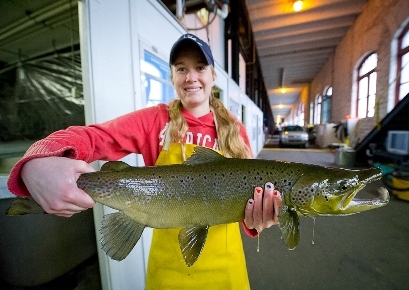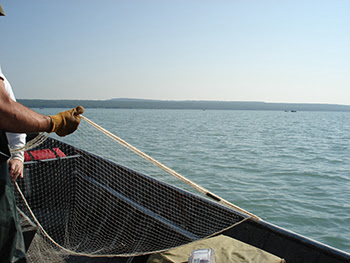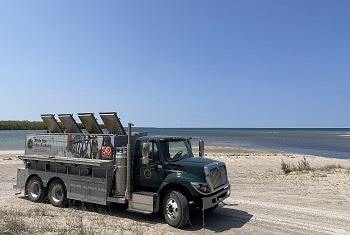More Atlantic Salmon in Michigan Waters
Michigan became world-famous when it made a daring effort to revitalize the Great Lakes sport fishery by stocking Pacific salmon in the 1960s. While Chinook and Coho fishing still remain very good overall, Michigan is now looking at residents of the other ocean to beef up the Great Lakes fishery: Atlantic salmon.
Highly prized around the world for their sporting characteristics, Atlantic salmon are currently thriving in the St. Marys River, the connecting water that drains Lake Superior and flows into Lake Huron. Michigan Department of Natural Resources’ Fisheries Division personnel hope to expand the Atlantic salmon fishery further into Lake Huron.
connecting water that drains Lake Superior and flows into Lake Huron. Michigan Department of Natural Resources’ Fisheries Division personnel hope to expand the Atlantic salmon fishery further into Lake Huron.
Atlantics already have a presence in Lake Huron, often turning up for sport fishermen in a number of ports. At times, the Atlantic salmon catch surpasses the Pacific salmon catch at some locations, such as De Tour.
“We’re not replacing Pacific salmon with Atlantics,” explained Todd Grischke, the DNR’s Lake Huron Basin coordinator. “We’re trying to bolster the existing fishery and create an additional river-return fishery in other locations.
“And we’re adapting to the changes in the ecosystem. Since the invasion of quagga mussels, the lake no longer produces the alewives that are necessary to support a large Chinook population.
“Atlantic salmon return to creel at a higher rate than any of our other stocked salmonoids,” Grischke continued. “We’re hoping to play off that success. The St. Marys fishery works. We want to make it even better, and we want to bolster the off-shore fishery, too.”
Although the DNR has been working with Atlantic salmon for decades, their presence in the St. Marys River falls to Lake Superior State University’s Aquatic Research Laboratory. The lab churns out the 25,000 Atlantic salmon annually that have created the fishery.
Originally begun as a way to give students hands-on training, the lab started with a grant from the Michigan Fish Producers Association to research whitefish. The lab began working with Atlantics in the 1980s when it received a shipment of eggs from Gull Lake, where the DNR was stocking Atlantics, as explained by Roger Greil, who runs the lab.
Despite several false starts – Atlantics are delicate fish, vulnerable to disease and environmental constraints – Lake Superior State University’s lab used the Michigan fish, and additional eggs obtained from Maine, to establish the Atlantics. The lab saw the first returns of the program in 1990 and soon began taking eggs from the returning salmon. By 2004, the lab began using only St. Marys River Atlantics for broodstock (mature male and female fish that are kept separate for breeding purposes).
Since then, the lab has been self-sustaining.
On site at the power house owned by a local power cooperative in Sault Ste. Marie, the lab not only produces the 25,000 Atlantics needed at the St. Marys River, but has also been sending surplus fish to the DNR for stocking in Torch Lake. Now the DNR is experimentally raising Atlantics at the Platte River State Fish Hatchery with an eye toward stocking Lake Huron.
“This year, for the first time, the fish are healthy, growing well and disease-free,” Grischke said. “We are attempting to produce 80,000 yearlings, which we’ll be stocking into Lake Huron. We’re still in the process of learning how to best rear this species at the hatchery, and still deciding how those fish will be allocated.”
Adult Atlantics usually begin showing up in the St. Marys River in June and are present in good numbers by the time the Aquatic Research Lab begins egg-take in the fall.
“We try setting our gill nets the last three days of October and we’ll hold the fish in our raceways,” explained Greil. “Normally our egg-take starts around Nov. 4 and is wrapped up by Nov. 14. We do two or three egg-takes a week, usually 25 to 30 females each time. Our goal is to do 100 pairs a year.
“We don’t have a lot of problems collecting the fish we need for egg-take. We capture what we can handle.”
Once captured, the fish are stripped of their reproductive products by hand and are fertilized on a one-to-one basis. The fertilized eggs are placed in egg trays.
By mid-December, Greil said staff starts seeing “eye-up” – a growth stage at which the eggs are determined to be viable – and hatching generally follows by the first of January. By mid-February, they’re moved into indoor raceways, and in June are transferred to larger rearing containers. The yearlings have to be moved out in June in order to make room in the larger raceways for the younger fish; otherwise, it gets awfully crowded.
The raceways that hold the fish can be drained directly into the river.
“Just being reared in the same water is what gives us a fairly high return rate,” Greil said. “We don’t see a lot of wandering, if any. They’ve been reported in the river up in Georgian Bay in the spring of the year, but I believe they are in there chasing smelt.”
“The only thing that’s transported is our surplus fish,” he added. That reduction in transportation is a big plus to the operation.
Greil is pleased with the Atlantic salmon-rearing program and optimistic about its future expansion. That’s good news for the resident and visiting sport fishermen eager to add Atlantics to their catch in coming seasons.
“It seems to be a good fishery,” he said. “We get people coming from all over to fish for them.”
To learn more about Lake Superior State University’s Aquatic Research Laboratory, visit www.lssu.edu/arl. To learn more about the Department of Natural Resources’ fish production, stocking and management programs, visit www.michigan.gov/hatcheries.






